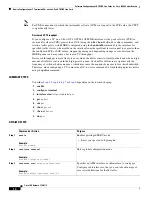
Software Configuration of ATM ISE Line Cards for Cisco 12000 Series Routers
How to Configure Layer 3 Terminated VCs on the 4-Port ATM ISE Line Card
20
Cisco IOS Release 12.0(27)S
Configuring Per-VC MDRR and Low Latency Queueing
This task configures egress MDRR.
Using egress MDRR, the 4-Port ATM ISE line card supports up to eight queues for classes of traffic per
VC. One of the queues is always reserved for a special class called class-default. Up to seven of the
classes are normal queues, including the class-default queue. The eighth class is always a low latency
queue.
The class, class-default, is always configured, and it consumes one of the eight queues. If not configured
explicitly, it is configured implicitly. When the
bandwidth
command is used, at least 1 percent of traffic
must be reserved for the class-default queue. All packets that do not match any user-defined class on the
policy map are considered to belong to class-default, and therefore enter the default queue.
The low latency queue, or priority queue, is also always created. All traffic sourced from the router
(including ping traffic and multicast traffic) uses this queue, regardless of classification.
Bandwidth percentages are converted into weights in units of ATM cells. The weights are internally
proportioned such that the bandwidth is divided accurately among VCs.
The following are recommendations for configuring per-VC MDRR on the 4-Port ATM ISE line card:
•
Set the bandwidth to be at least 10 percent in each class. The default class, class-default, should also
have at least 10 percent of the bandwidth allocation; therefore, you should ensure that the bandwidth
allocated to all configured classes is less that 90 percent.
Step 9
random-detect
dscp
dscpvalue
min-threshold
{
cells
|
packets
}
max-threshold
{
cells
|
packets
} [
mark-probability-denominator
]
Example:
Router(config-pmap-c)# random-detect dscp 1 300
cells 700 cells 1
Specifies the minimum and maximum cell thresholds and,
optionally, the mark-probability denominator for the DSCP
value.
Specify
cells
for egress and
packets
for ingress.
Note
Use this step to configure DSCP-based WRED.
Step 10
exit
Exits policy-map class mode.
Step 11
exit
Exits policy-map mode.
Step 12
interface atm
slot
/
port.subifnum
Example:
Router(config)# interface atm1/0.1
Specifies the ATM subinterface to configure.
Step 13
pvc
vpi
/
vci
Example:
Router(config-subif)# pvc 1/1
Specifies the ATM PVC to attach the policy map to.
Step 14
service-policy output
policy-name
Example:
Router(config-if-atm-vc)# service-policy output
wred-1
Attaches the policy map to the PVC.
Command or Action
Purpose






























